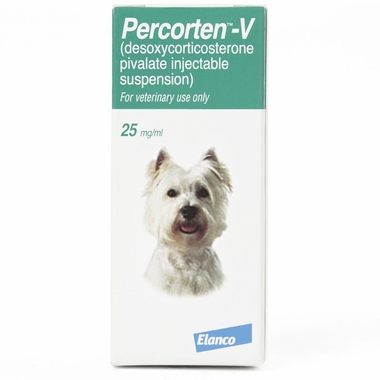In treating canine hypoadrenocoricism, Perforten-V replaces the mineralcorticoid hormones only. Glucocorticoid replacement must be supplied by small dail doses of glucocorticoid hormones (e.g., prednisone or prednisolone (0.2 - 0.4 mg/kg/day).
Dosage requirements are variable and must be individualized on the basis of the response of the patient to therapy. Being treatment with Percorten-V at a dose of 1.0 mg per pound of body weight every 25 days. In some patients the dose may be reduced.
Serum sodium and potassium levels should be monitured to assure the animal is properly compensated. Most patients are well controlled with a dose range of 0.75 to 1.0 mg per pound of body weight, given every 21 to 30 days.
The well-controlled patient will have normal electrolytes at 14 days after administration or may exhibit slight hyponatremia and hyperkatemia. This needs no additional therapy as long as the patient is active and eating normally. Watch closely for depression, lethargy, vomiting, or diarrhea which indicate a probable glucocorticoid deficiency.
At the end of the 25-day dosing interval. the patient should be clinically normal and have normal serum electrolytes. Alternatively, they may have slight hyponatremia, and slight hyperkalemia. This constellation of signs indicate that the dosage and dosage interval should not be altered.
If the dog is not clinically normal or serum electrolytesare abnormal, then the dosage interval should be decreased 2-3 days.
Occasionally, dogs on Percorten-V therapy may develop polyuria and polydipsia (PU/PD). This usually indicates excess glucocorticoid, but may also indicate a Percorten-V excess. It is prudent to begin by decreasing the glucocorticoid dose first. If the PU/PD persists, then decrease the dose of Percorten-V without changing the interval between doses.
















